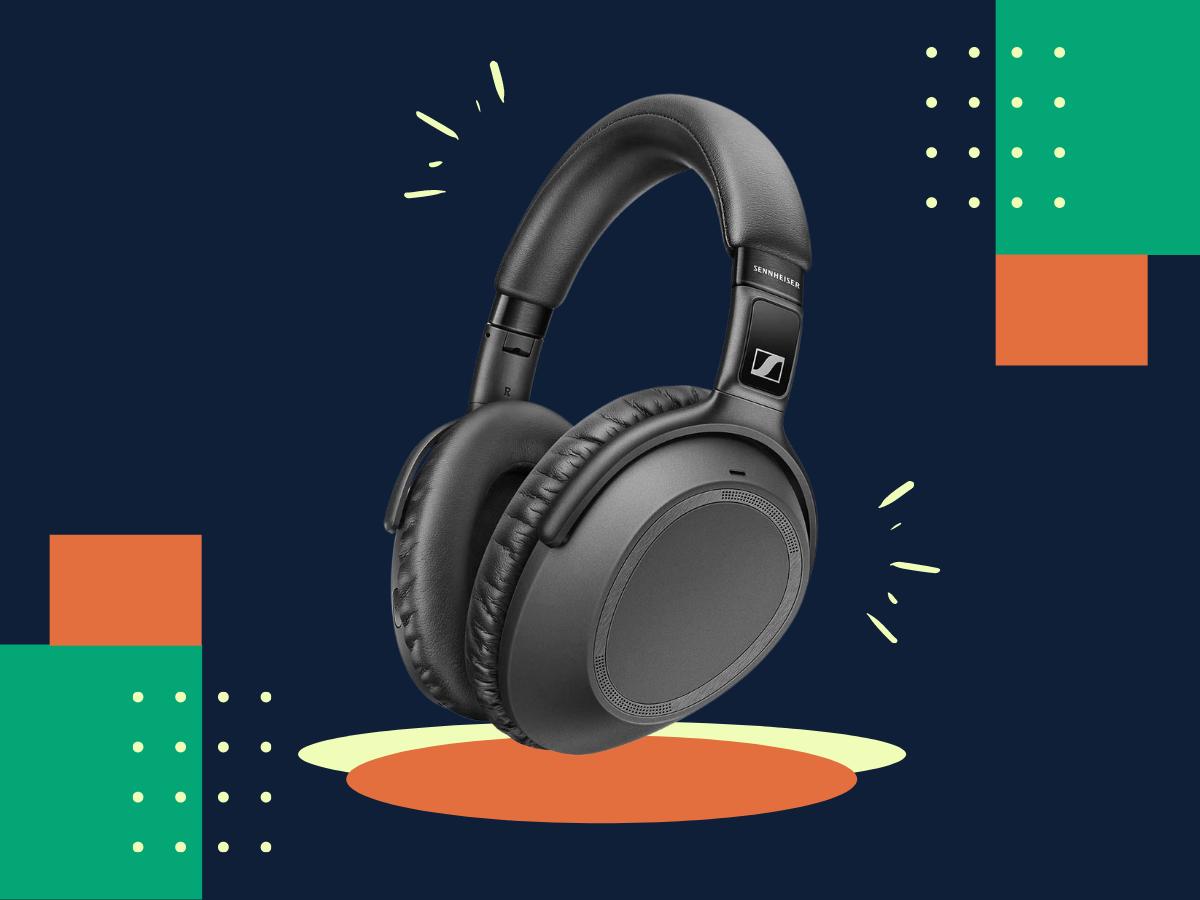The best Sennheiser headphones can impress anyone from beginners in the audio industry to the biggest fans of the brand.
| Name | Type | Connectivity | Frequency Range | Price |
|---|---|---|---|---|
| Sennheiser PXC 550-II Best Overall | Closed-back, Over-ear | Wired/wireless | 17 - 23kHz | BUY |
| Sennheiser Momentum 3 Strong Runner-Up | Closed-back, Over-ear | Wired/wireless | 6 - 22kHz | BUY |
| Sennheiser HD 559 Best Budget | Open-back, Over-ear | Wired | 14 - 26kHz | BUY |
| Sennheiser HD 800 S Legendary Pick | Open-back, Over-ear | Wired | 4 - 51kHz | BUY |
| Sennheiser HD 820 Best Closed-back Sound Quality | Open-back, Over-ear | Wired | 6 - 48kHz | BUY |
| Sennheiser IE400 Pro Best for In-Ear Monitoring | IEMs | Wired | 16 - 19kHz | BUY |
| Sennheiser RS 195 RF Wireless Best for TV | Closed-back, Over-ear | Wireless (RF) | 17 - 22kHz | BUY |
| EPOS Sennheiser GSP 600 Best for Gaming | Closed-back, Over-ear | Wired | 10 - 30kHz | BUY |
| Sennheiser Momentum True Wireless 2 Best for Listening on the Go | True Wireless | Wireless | 5 - 21kHz | BUY |
| Sennheiser CX Plus Best for Sports | True Wireless | Wireless | 5 - 21kHz | BUY |
How to Choose the Best Sennheiser Headphones
From 1945 up until now, Sennheiser has been one of the biggest audio brands in the world, catering to both professionals and casual listeners.
However, choosing the best Sennheiser headphones is not easy. While most of the brand’s products are good, there are headphones from Sennheiser that stand above the rest.
Plus, to find the best Sennheiser headphones, you also have to find the one that will suit your lifestyle and setup. Your preference for sound, comfort, and budget will matter a lot.
To aid you in that choice, here are the factors to consider when choosing the best Sennheiser headphones for you:
What will you use them for?
Sennheiser has a plethora of headphones categorized in a couple of categories, targeting different purposes and users.
The best Sennheiser headphones are the ones that are right for your needs. For example, if you’re someone who is always on the go, you need headphones that are light and portable. On the other hand, professionals who work in studios need headphones that are wired and breathable.
So, to find the best one for you, you need to determine what your lifestyle demands. This involves matching the form factor, connectivity, build and features to your needs.
Form factor
Form factor pertains to the overall design and shape of the headphones. Like most brands, Sennheiser offers over-ear headphones, on-ear headphones, and in-ear monitors (IEM).
Different types of headphones cater to different users. Some users, mostly those who tend to wear their headphones for long periods, prefer over-ear headphones. On-ear headphones are more portable so commuters would usually prefer these. Finally, in-ear and earbuds are for those with an active lifestyle — perhaps athletes or regulars at the gym.
Wired vs wireless
When it comes to the connectivity of the headphones, you can go two ways: wired or wireless.
Wired headphones usually have better sound quality since manufacturers can spend more on developing the sound instead of working on connectivity. Also, these headphones have lower audio latency as they transmit audio signals directly from the source without interference.
However, the wire can break easily and gets in the way of movement. You can also face compatibility issues if your headphones do not match the port on your device.
Wireless headphones, on the other hand, are more portable and allow you to move freely. Compatibility won’t be much of a concern as well since wireless headphones often connect with most modern smartphones and devices with Bluetooth.
However, interferences can get in the way of proper pairing and the latency performance of these headphones.
Open-back vs closed-back
Airflow affects what you hear and how you feel when wearing the headphones. For this, you can choose from open-back or closed-back headphones.
Open-back headphones have ear cups that allow air to flow in and out freely. These headphones prevent moisture and pressure build-up for less ear fatigue and a more comfortable feel.
However, open-back headphones are prone to leaking sound — both inward and outward. These headphones are only for those who are in an environment where external sounds are not as apparent.
Closed-back headphones, as the name suggests, have ear cups that are fully covered. Because of their design, sounds are less likely to leak and external noise is less likely to penetrate. These headphones provide users with a more immersive listening experience.
If you’re a music producer or someone who stays in a quiet environment, open-back headphones are for you. On the other hand, if you interact with the public a lot like a commuter, you should go for closed-back headphones. If you’re on a budget, closed-back headphones are more likely to be along your alley as well.
Additional features
There’s no shame in searching for headphones with more specific features. At the end of the day, these features will make the listening experience better. When talking about additional features, here are some that come to mind:
- Active Noise Cancellation (ANC): Headphones with ANC emit sound waves that negate incoming external sounds. ANC headphones are for people who need to block out noise to concentrate or relax properly.
- Microphone: For professionals, gamers, streamers, or anyone who handles calls every now and then, a mic is a must.
- Companion App: The Sennheiser Smart Control app allows users to tweak their headphones and turn on additional features like noise cancellation. If you want access to this app, be sure to find Sennheiser headphones that are compatible with it.
The Sennheiser sound quality
Brands like Bose target casual listeners while Audio Technica caters to audiophiles and producers. However, what makes Sennheiser different is that they target both of these markets efficiently by creating four different headphone lines.
The brand’s IE and HD lines feature Audiophile headphones. These headphones are great for music professionals and those who want to hear with high fidelity. Headphones in these series have larger drivers, closer to neutral sound signatures, and open backs.
Meanwhile, the Momentum and CX lines are good for daily commutes and physical activities. Headphones in these series do not sound as good as their high-end counterparts. However, these headphones are lightweight, water-resistant, and boast features like ANC.
Aside from these, Sennheiser’s headphones are characterized by several factors. These are the things you have to carefully think about to make the right decisions:
Frequency response
Humans can only hear up to 20Hz to 20KHz. This is why most headphones are made to produce sounds within this range. Anything that goes lower or higher than these numbers will not be heard but can be felt.
Some Sennheiser headphones exceed the limits widely with ranges of 4 Hz – 51KHz. This prevents bass or treble roll-offs when approaching the frequency limits. Having a frequency lower than 20Hz also means that users will get to feel more frequencies, making the listening experience more immersive.
Sound signature
The sound signature pertains to the sound characteristic the headphones add to the music. One sound signature may result in a heavier bass and muffled vocals while another sound signature can be the opposite.
Sennheiser does not exactly specialize in one specific sound signature. Instead, Sennheiser tends to stay in the middle and release products that will cater to people with different preferences.
For professionals like sound engineers and producers, both neutral and analytical sound signatures are strongly preferred.
For example, the Sennheiser HD 560S has an analytical signature while the HD600 is neutral.
Another type of sound signature is called V-Shaped. This sound signature is characterized by enhanced low and high frequencies, with slightly decreased mids. The result is a stronger bass and crisp highs. V-Shaped headphones are great when listening to lively genres like Pop, Hip-Hop, and Rock. The Sennheiser IE 300 are in-ear headphones with this particular sound signature.
For those who wish to hear lower frequencies better, the dark sound signature is for you. This sound signature has increased low frequencies and low mids. As a result, the sound produced is extremely immersive and may even sound muffled. The Sennheiser HD 650 comes into mind when talking about this sound signature.
Drivers
Drivers are the main engines inside headphones that are responsible for producing the sound you hear. There are many types of drivers but Sennheiser is known to use Dynamic drivers even in their most high-end options.
Dynamic drivers are known for their ability to cover a wide range of frequencies. Apart from that, they can also vibrate stronger to produce more air resulting in punchier bass.
Sennheiser continues to experiment with Dynamic drivers. They constantly work on adding things that will make the headphones sound and feel better.
Case in point, all Sennheiser HD headphones contain linear HD drivers. This technology produces cleaner low-frequency bass. In addition to that, Sennheiser also has the ActiveGard™ technology. This smooths out sounds to protect users from sudden peaks in volume.
Sennheiser also developed TrueResponse transducers. These small drivers were developed to remove unwanted distortions. The results are cleaner sounds in smaller products like earbuds.
Compatibility with your setup
To utilize your headphones properly, their impedance or required voltage should match what your source can give off. If not, your headphones won’t be able to get enough electricity to perform the way they should. This concept is called impedance matching.
For some Sennheiser headphones, impedance matching is not an easy task. This is because most portable devices like smartphones have low power output while most high-end headphones have high power requirements. To match impedance, you would need to find either a device with a high power output or headphones with a lower requirement. Another option is to connect both your devices to a DAC or amp to control the current better.
The power that your headphones receive is also related to the headphones’ sensitivity.
Sensitivity pertains to the efficiency of the product to convert electronic signals into undistorted sound.
The majority of headphones usually have a sensitivity of 85dB – 105dB. The lower the sensitivity of your headphones is, the higher the power you’ll need to make your headphones sound louder. Headphones with higher sensitivity need less power but you should be wary of distortions when the output volume is maxed.
Comfort
Comfortable headphones ensure that you’re not bothered by pains or nuances when you’re listening. And, to find comfortable headphones, you need to decide on their padding, weight, and adjustability.
- Padding: Sennheiser’s usual padding of choice is velour which is a plush of knitted velvet. Even though this type of padding is not that breathable and not easy to clean, they absorb vibrations well and are generally comfortable.
- Weight: As for the weight, Sennheiser headphones tend to weigh a little higher than usual at around 0.5 to 3 lbs on average. When worn for long periods, heavy headphones can cause neck strains and even ear fatigue due to the strong clamping force.
- Adjustability: Sennheiser headphones have adjustable headbands and are usually foldable but do not have a lot of swivel in them. The brand’s IEMs, on the other hand, have replaceable ear tips for better fit and comfort.
Value for money
Admittedly, Sennheiser is not a brand that you would call affordable. Even though the brand has some budget options, you would need at least $100 to get their best offerings. In fact, Sennheiser’s premium headphones, like the new HD 820, can even reach up to $2000.
Despite the high price point, Sennheiser has remained an institution in the industry for good reason. Sennheiser headphones rival the best of the best when it comes to sound and build quality.
At the end of the day, the best headphones are the ones that cater to your needs seamlessly. It doesn’t matter how expensive or affordable your headphones are, as long as they’re right for you — it will all be worth it.
One of Sennheiser’s strongest entries and a great sample of value-for-money are the Momentum 3 headphones. These headphones are on par both in performance and price range with industry leaders like Sony WH-1000XM4, and Bose QuietComfort 45. Despite being in the same price range, the Momentum 3 holds the following advantages over the two other headphones:
- Neutral Sound Signature – A neutral sound signature allows users to hear all parts of the sound at equal levels. With this, the Momentum 3 passes audiophile standards and can even be used professionally.
- USB Audio (USB-C) – This connectivity option allows the headphones to connect directly to gaming consoles and most modern smartphones. Also, USB Audio typically has better sound quality.
- 42mm Dynamic Driver – With the largest driver among the three headphones, the Momentum 3 can produce higher volumes. Large drivers also move more air for a more immersive bass.
Clearly, Sennheiser made these headphones to contend for the top spot. And, other creations from Sennheiser are not to be taken lightly as well.
10 Best Sennheiser Headphones [2023]
Sennheiser PXC 550-II
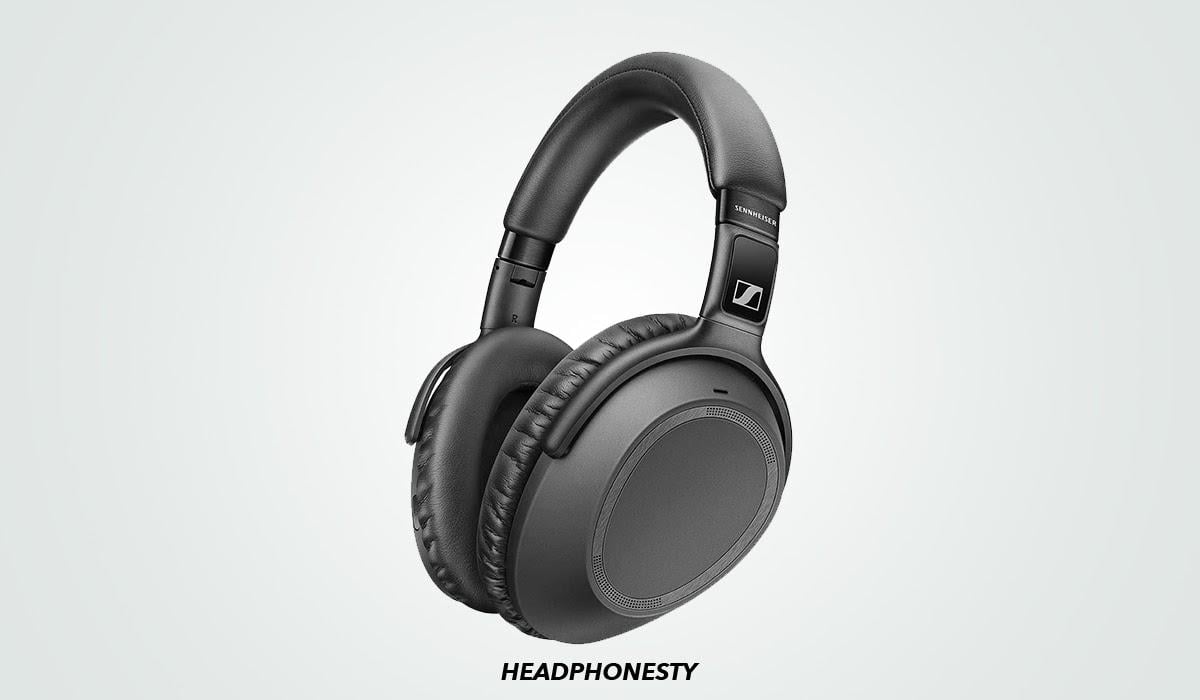
Key features
- Type: Closed-back, Over-ear
- Connectivity: Wired/wireless
- Bluetooth audio codecs: SBC, aptX™, aptX™ Low Latency, AAC
- Battery Life: 30 hours
- Frequency Range: 17 – 23kHz
- Sensitivity: 110 dB
- Impedance: 490 ohms (w/ ANC), 46 ohms (w/o ANC)
- Mic: Yes
- ANC: Yes
- App Support: Sennheiser Smart Control
The Sennheiser PXC 550-II takes the top spot thanks to their complete set of features. These headphones epitomize the brand’s effort to constantly evolve with today’s style and technology
One of the biggest assets of the PXC 550-II is the NoiseGard Adaptive Noise Cancellation, which adapts to the changing environments and automatically adjusts the level of ANC used, giving you a disturbance-free listening experience.
With a rather large 32mm Dynamic driver, the PXC 550-II can produce loud and clear sounds, especially partnered with the balanced sound signature. This gives your music just enough emphasis and crisp in the higher frequencies, without leading to ear fatigue. Not to mention, the PX 550-II has a wide frequency range of 17 – 23kHz which gives it deeper bass and detailed highs.
When it comes to comfort, the PXC 550-II have ear cups that are shaped like a pointed oblong with a forward slant to cover the ears more comfortably. Aside from the unique shape, the right ear cup also features a full touchpad that makes controlling the headphones easier and less confusing.
These headphones can be used both wired and wirelessly. The 30-hour battery life is also a great asset for daily commuters and frequent travelers. They also have Smart Pause and access to the Sennheiser Smart Control app. All these features make the Sennheiser PXC 550-II extremely user friendly and convenient for everyday use.
The 550-II charges fully in 3 hours because it has a microUSB charging port. This is a letdown because most of their competitors now use USB-C capable of fast-charging headphones within an hour.
Sennheiser Momentum 3
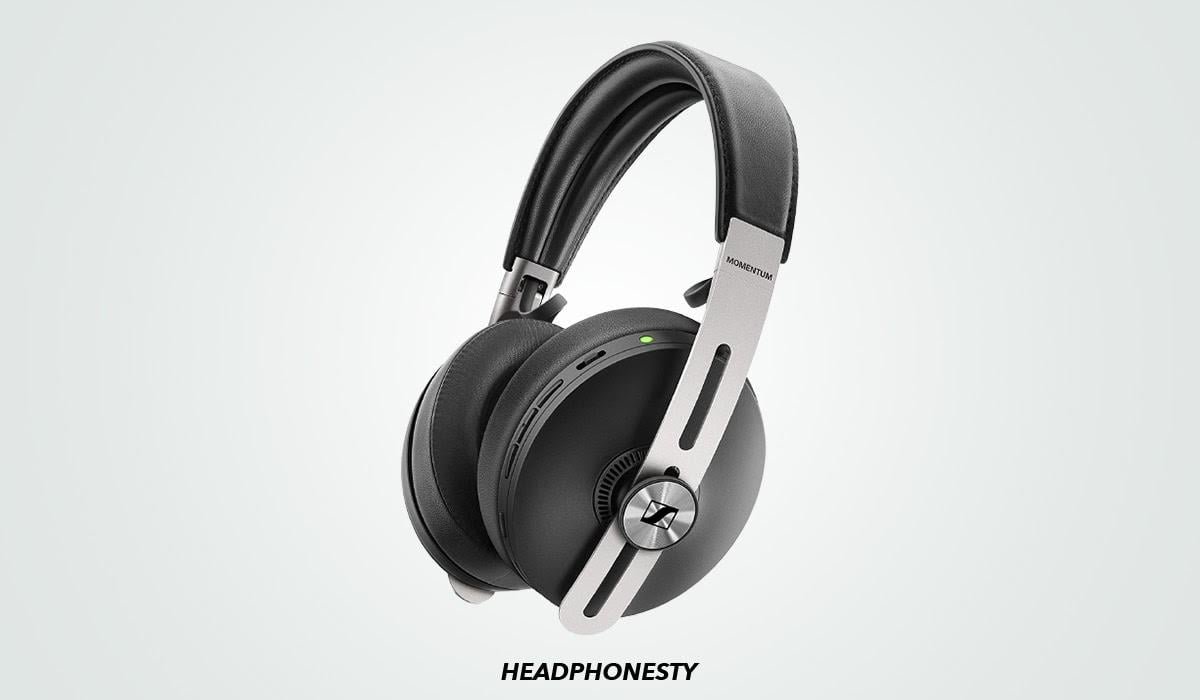
Key features
- Type: Closed-back, Over-ear
- Connectivity: Wired/wireless
- Bluetooth audio codecs: SBC, aptX™, aptX™ Low Latency, AAC
- Battery Life: 17 hours
- Frequency Range: 6 – 22kHz
- Sensitivity: 118 dB
- Impedance: 470 ohms (w/ ANC), 100 ohms (w/o ANC)
- Mic: Yes
- ANC: Yes
- App Support: Sennheiser Smart Control
Comfort, portability, and functionality are the things that make the Sennheiser Momentum 3 one of the top pairs in the Sennheiser brand.
With humongous 42mm drivers and a warm sound signature, these headphones will give you an immersive listening experience with little emphasis on the bass. The Momentum 3 also has a very wide frequency range of 6 – 22kHz, making loud headphones with a lot of oomph.
For battery, the Momentum 3 feature a 17-hour battery life with fast charging that can render 1.5 hours of playback from a 10-minute charge. This level of fast charging is considered cutting-edge these days and can really help out frequent travelers.
Momentum 3’s accessibility features are bannered by a three-button interface that puts important commands at the tip of your fingers. Voice-assistant integration, as well as Smart Pause, are also two features that make hands-free controlling easier.
The Momentum 3 are very comparable with our top pick, the PXC 550-II.
Case in point, like the PXC 550-II, noise cancellation is also one of the Momentum 3’s biggest assets with 3 levels of ANC. This, together with the Transparent Hearing feature, lets you choose how you want to hear your music for a tailored experience. All these can also be accessed through the Sennheiser Smart Control app
However, the PXC 550-II features a balanced and almost professional-like sound signature while the Momentum 3 is warmer. So the PXC 550-II are better for those who enjoy lifelike sound quality.
Sennheiser also went with genuine leather ear pads for the Momentum 3 that have less ventilation than the PXC 550-II’s velour padding.
Sennheiser HD 559
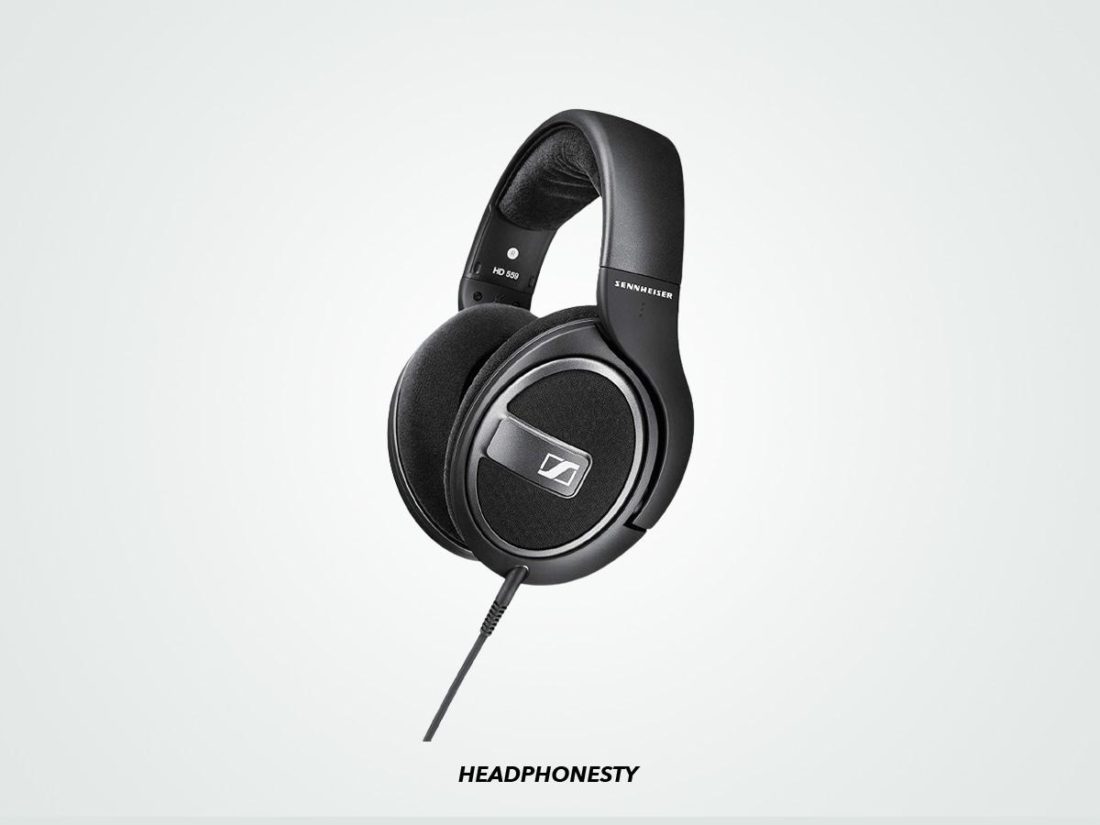
Key features
- Type: Open-back, Over-ear
- Connectivity: Wired
- Frequency Range: 14 – 26kHz
- Sensitivity: 108 dB
- Impedance: 50 ohms
- Mic: No
- ANC: No
- App Support: N/A
The Sennheiser HD 559 do not have ANC and wireless connectivity, thus the more affordable price tag. However, what they lack in features, they make up for with audiophile sound quality and a slightly warm but overall balanced sound signature. They also have a frequency range of 14 – 26kHz that is wide enough to reach deep bass and extreme highs.
Aside from the sound quality, one of the biggest assets of these headphones is comfort. The 38mm drivers produce loud sounds but the headphones’ open-back design prevents pressure and moisture build-up.
In addition to the open-back design, they also feature velour ear pads so that the headphones can stay comfortable for hours. These ear pads are also replaceable so you can adjust them for better comfort.
The Sennheiser HD 559 are great for professionals or meticulous users who want to enjoy superb sound quality in quiet spaces like their homes. The low impedance of 50 ohms also makes these headphones easily compatible with most smartphones.
The cable is one facet of the headphones that need to be developed further though. Being 3 meters in length, these cables can easily get caught in things at home. Also, instead of the standard and universal 3.5mm jack, Sennheiser went with a 6.3mm connection for these headphones. So, if you want to use this with standard aux connections, you’ll need to buy a 6.3mm to 3.5mm adapter.
Sennheiser HD 800 S
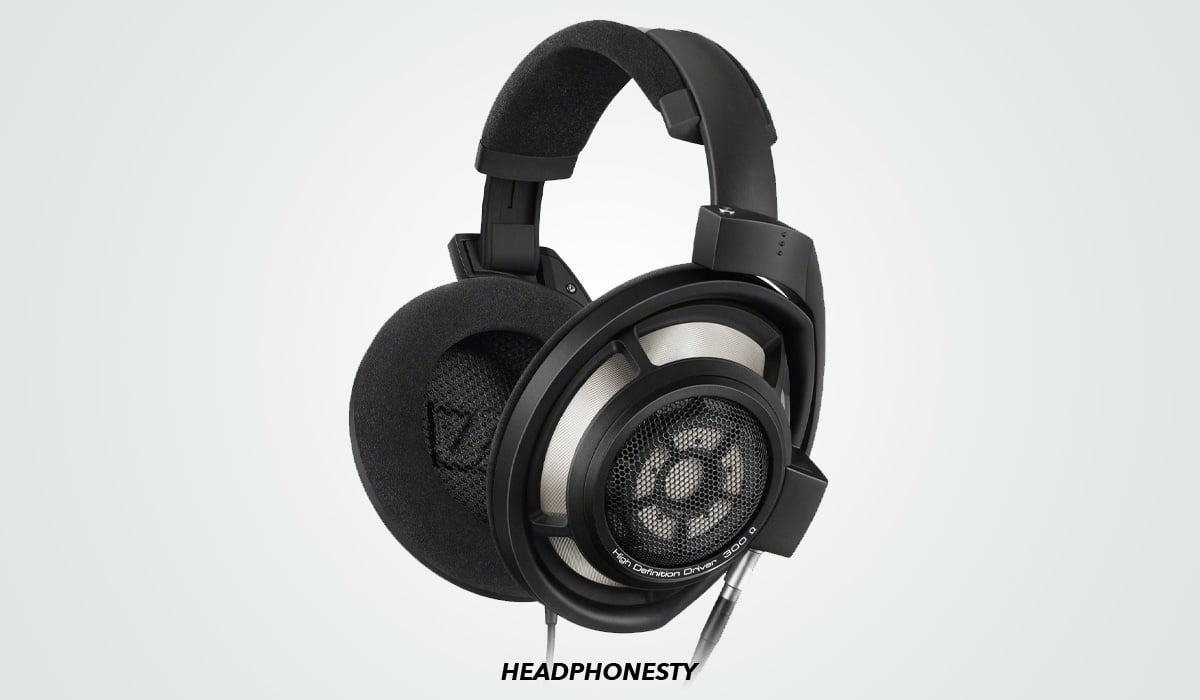
Key features
- Type: Open-back, Over-ear
- Connectivity: Wired
- Frequency Range: 4 – 51kHz
- Sensitivity: 102 dB
- Impedance: 300 ohms
- Mic: No
- ANC: No
- App Support: N/A
Legendary is a word that best describes the Sennheiser HD 800 S. These were carefully crafted by Sennheiser to be one of the best neutral headphones today by adding unique supporting elements that highlight their sound signature.
For starters, these headphones feature open-back ear cups that are slanted in a way that the sound waves are directed into your ears without obstructions. Because of this, even the slightest nuances of the music can be heard and checked out by producers. Their 4 – 51kHz frequency range is also the widest in Sennheiser and helps the 800 S produce finer sound details.
In addition to that, the headphones also have a vibration-damping chassis that reduces unwanted frequencies that can possibly mask mixing errors. They also feature one of the largest drivers ever used in dynamic headphones at 56mm. The massive drivers are not just loud — they also produce cleaner bass.
Instead of the usual velour ear pads, Sennheiser went with handmade ultra-soft microfiber for the HD 800 S. These ear pads conform to the shape of your head which results in comfortable listening hours.
The trade-off for the superb quality is a massive 300 ohms impedance. Also, their 3-meter cable features a 6.3mm connection instead of the standard 3.5mm. Because of these things, you can’t simply use these headphones without the right setup. If you’re not someone who needs to hear music for a living, these are not for you.
Sennheiser HD 820
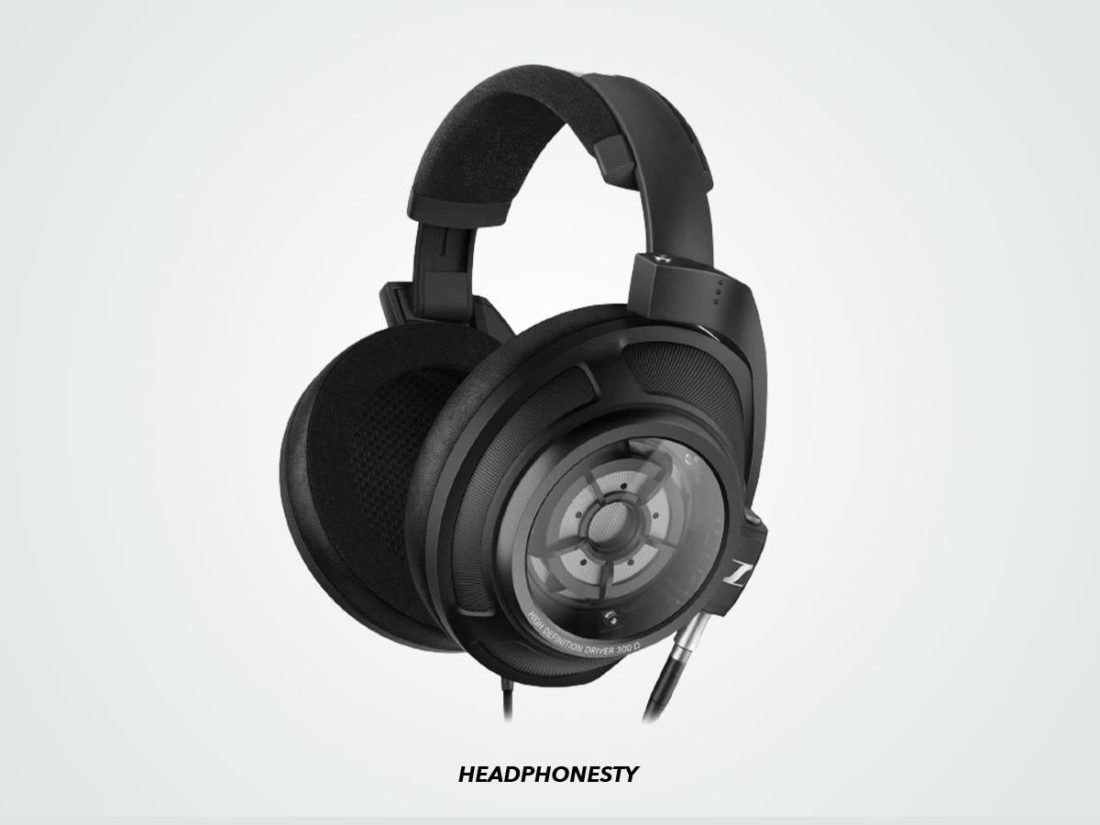
Key features
- Type: Closed-back, Over-ear
- Connectivity: Wired
- Frequency Range: 6 – 48kHz
- Sensitivity: 103 dB
- Impedance: 300 ohms
- Mic: No
- ANC: No
- App Support: N/A
Despite having striking similarities with the HD 800 S, the Sennheiser HD 820 manages to stand on their own as the best closed-back option on this list. These headphones bring the iconic sound of the HD 800 S to a closed-back form.
With a frequency range of 6 – 48kHz, the HD 820 are able to produce anything from low bass to extreme highs. These headphones also have the same massive 56mm Ring Radiator drivers used by the HD 800 S to produce loud sounds that do not distort at higher frequencies.
The ear cups of the HD 820 are closed off by transparent and lightweight Gorilla Glass thus the closed-back form. This keeps the air inside and isolates external noise. While this results in a slightly narrow soundstage, it also adds a more impactful bass that gives the HD 820 a warm signature.
Comfort is another strong suit of the HD 820. They are relatively light at 360g and feature handmade ultra-soft microfiber that conforms to the shape of your head for a snug fit.
Much like the HD 800 S, these headphones also come with a 6.3mm connector and a 4.4mm Pentacon balanced cable to allow users to connect the headphones to even more sources.
Sennheiser IE 400 Pro
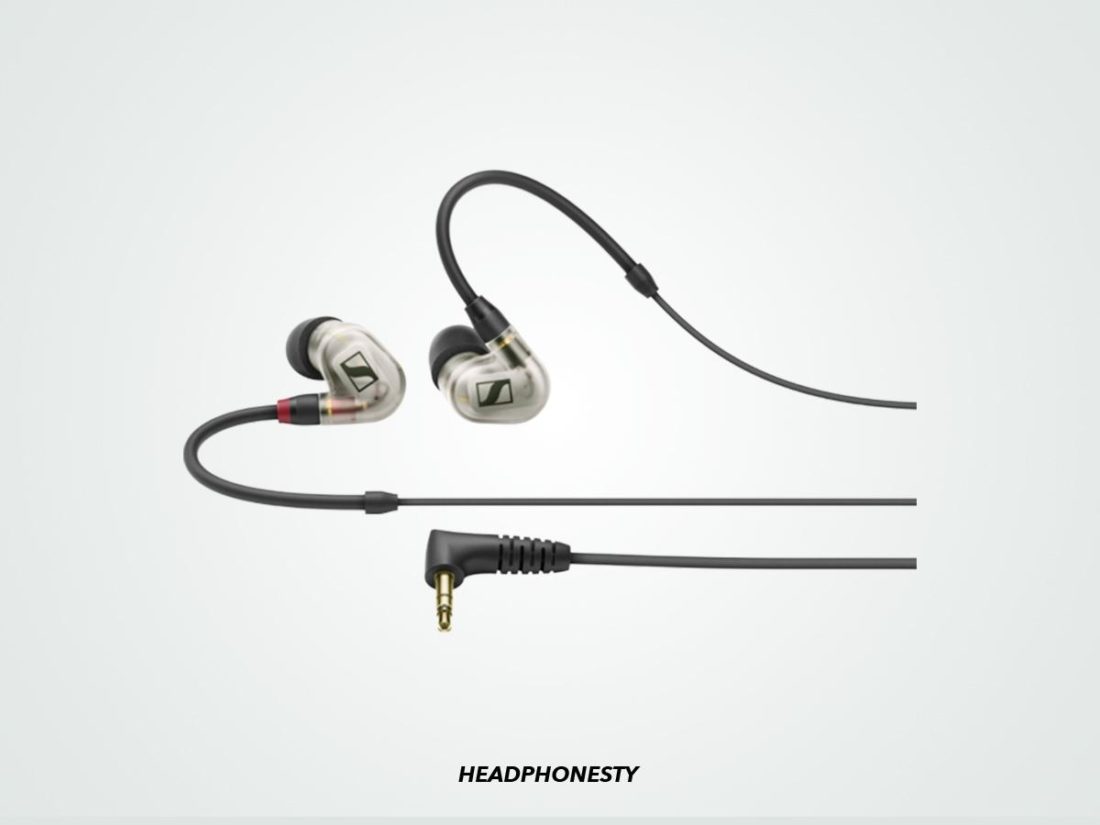
Key features
- Type: IEMs
- Connectivity: Wired
- Frequency Range: 6 – 19kHz
- Sensitivity: 110 dB
- Impedance: 16 ohms
- Mic: No
- ANC: No
- App Support: N/A
Audiophile headphones in your pocket — this is what makes the IE 400 Pro special. Clarity is one of these IEM’s specialities and these also have a slightly warm but overall balanced signature that is great for monitoring.
These IEMs use 7mm dynamic drivers that feature Sennheiser’s TrueResponse system. This system reduces acoustic stress factors resulting in distortion-free sounds. To add to that, these IEMs also have an absorbing resonator chamber that improves clarity.
A total of six options for ear tips are included with the IE 400 Pro. Three pairs varying in size (S, M, L) are silicone while another three pairs are memory foam. Silicone tips are easier to clean and have more prominent bass and vocals. Meanwhile, memory foam ear tips have better noise isolation without sacrificing comfort.
With an impedance of 16 ohms and a built-in 3.5mm connection, you can easily drive these with your average smartphone. They also come with a 3.5mm to 6.3mm adapter should you need to use it with a pocket amp on-stage.
The 6 – 19kHz frequency range is wide but misses out on higher frequencies in the 20kHz region. The quality of the memory foam ear tips also leaves a lot to be desired. Apart from losing their shape in a matter of weeks, the noise isolation of these ear tips is also not good enough.
Sennheiser RS 195 RF Wireless
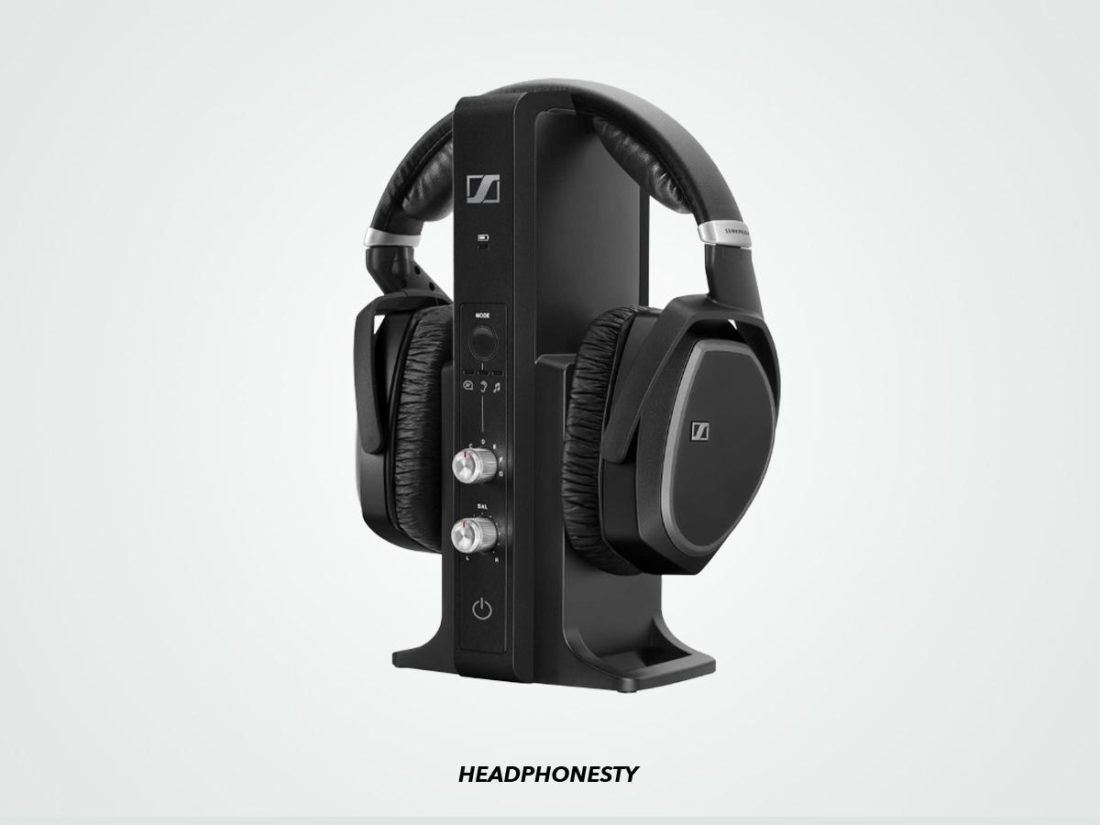
Key features
- Type: Closed-back, Over-ear
- Connectivity: Wireless (RF)
- Bluetooth audio codecs: N/A
- Battery Life: 18 hours
- Frequency Range: 17 – 22kHz
- Sensitivity: 117 dB
- Impedance: N/A
- Mic: No
- ANC: No
- App Support: N/A
The Sennheiser RS 195 RF Wireless stands out with their specific set of features that uniquely cater to TV.
These headphones feature two listening modes: speech mode and music mode. Speech mode eliminates background noise and enhances the clarity of speech. You’ll hear the movie character even if they whisper or when the background music gets loud. The music mode, on the other hand, equalizes sounds in a way that you’ll hear both the music and the vocals clearly.
Instead of Bluetooth, the RS 195 RF use Radio Frequency. RF has the ability to pass through walls and solid objects making these headphones the best choice for home use. And, in the case of the RS 195 RF, you’ll stay connected even if you’re 100 meters away. Also, these headphones can work with minimal audio compression resulting in better sound quality and shorter latency.
Controllability is also another important factor for TV headphones. This is so that you won’t need to fumble the remote or get up just to go to the TV just to access basic functions like volume.
In the case of RS 195 RF, the headphones themselves have a three-button control panel on the right ear cup that you can use to adjust volume and change listening modes. The multi-purpose transmitter also has a button to change modes and sliders for other controls.
The combination of the ergonomic design and thick velour ear pads works well for comfort. These ear pads are replaceable so you can get a pair that will fit you better.
However, the external material for the pads flakes easily so you’ll probably need replacement ear pads from time to time. In addition to that, their noise isolation is not good so they are only recommended for those who have quiet spaces at home.
EPOS Sennheiser GSP 600
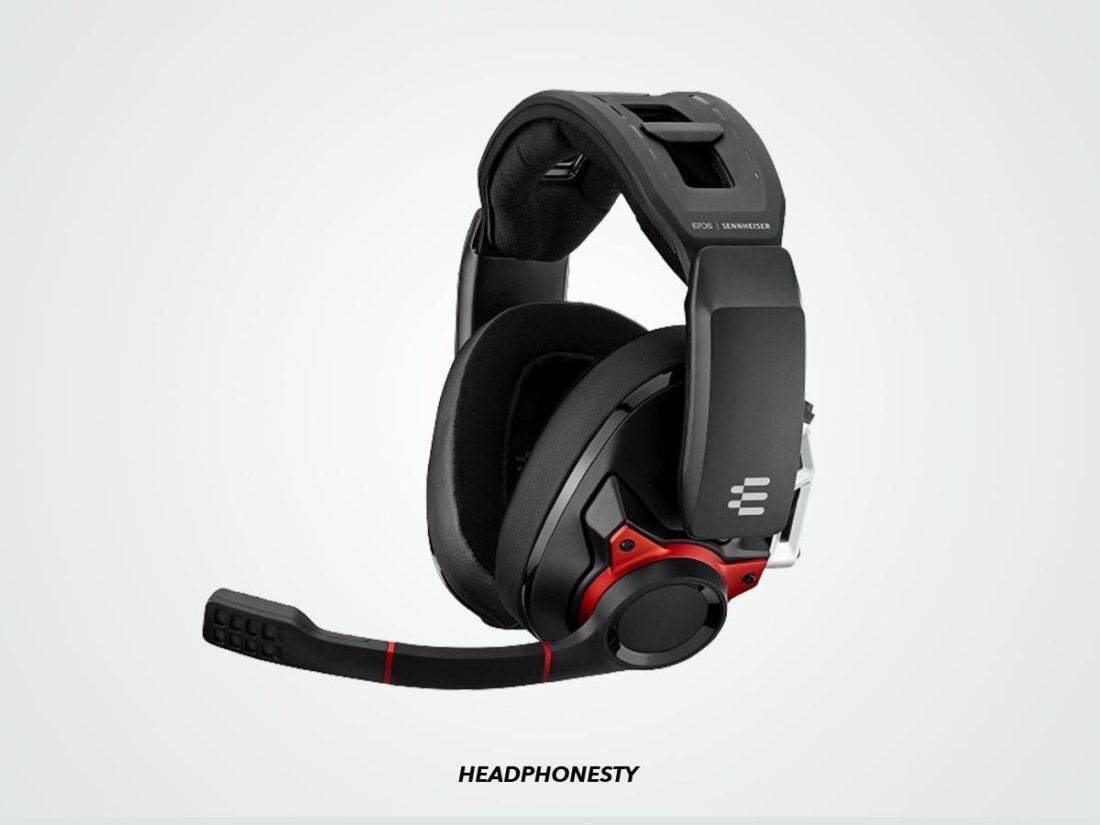
Key features
- Type: Closed-back, Over-ear
- Connectivity: Wired
- Bluetooth audio codecs: N/A
- Battery Life: N/A
- Frequency Range: 10 – 30kHz
- Sensitivity: 112 dB
- Impedance: 28 ohms
- Mic: Yes
- ANC: No
- App Support: N/A
Sennheiser was never really a gaming company. However, through several partnerships, Sennheiser was able to cultivate several brands including EPOS — a brand of headphones that cater to enterprises and gamers. And, with EPOS came the powerful Sennheiser GSP 600.
Right off the bat, the GSP 600’s design screams comfort. Their thick memory foam ear pads contort around your ears for a snug seal that isolates noise. This complements the Sennheiser transducers to provide immersive bass. The paddings are also finished with a suede leatherette coat that is breathable and gentle on the skin.
The GSP 600 feature an adjustable contact pressure headband. This special design provides a customized fit that has the weight of the headphones sit comfortably on your head.
For gamers, a microphone is non-negotiable, so it’s great that the GSP 600’s flip-to-mute boom mic produces a natural sound. The noise-cancelling feature of this mic also clarifies the input even more. Unfortunately, EPOS weren’t able to extend the noise-cancelling feature to the headphones themselves.
Moreover, with an impedance of 28 ohms and two cable options, the GSP 600 are easily compatible with all gaming platforms. This includes smartphones, PCs, and consoles like Nintendo Switch, PS5, and Xbox.
The trade-off for these headphones’ wide compatibility and low impedance is mediocre sound quality. These are analog headphones so the sound quality is dependent on the source. To improve sound quality, you’ll need to spend again for an amp like the GSX1000.
The contact pressure headband works well at the start. But, 7 to 8 hours into gaming, you’ll end up feeling the weight of the headphones.
Sennheiser Momentum True Wireless 2
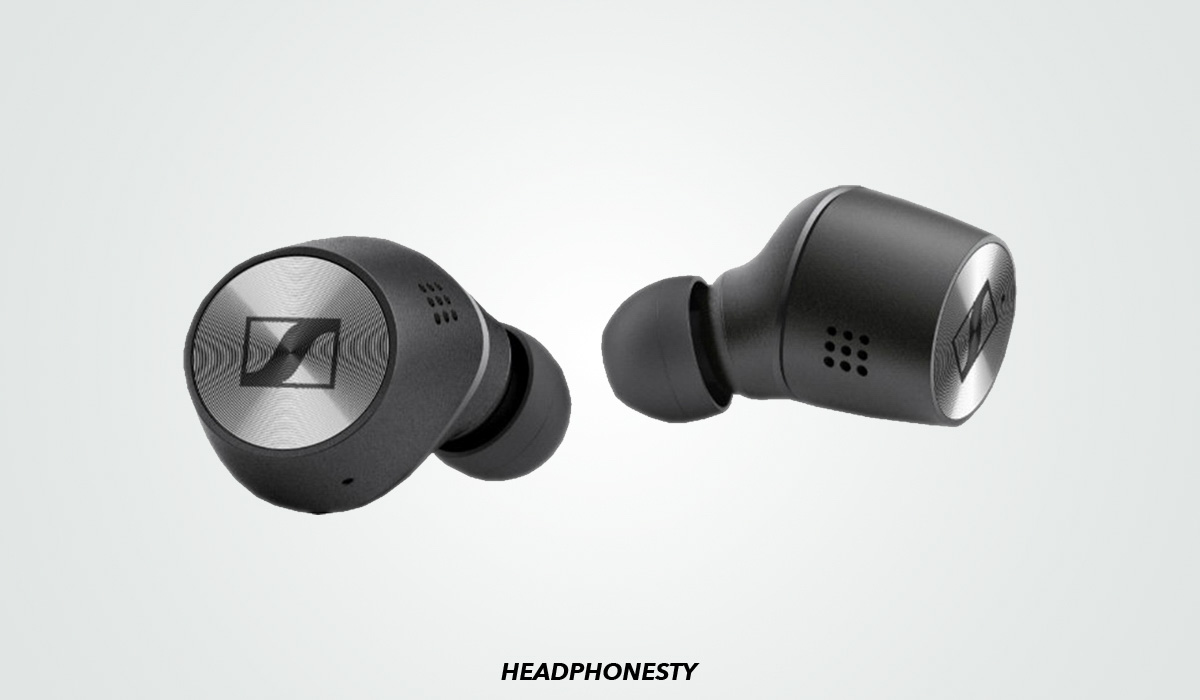
Key features
- Type: True Wireless
- Connectivity: Wireless
- Bluetooth audio codecs: SBC, AAC, aptX™
- Battery Life: 7 hours
- Frequency Range: 5 – 21kHz
- Sensitivity: 94 dB
- Impedance: N/A
- Mic: Yes
- ANC: Yes
- App Support: Sennheiser Smart Control
The MOMENTUM series is a collection of headphones made for traveling and exercising. Instead of audiophile audio, products in this line emphasize convenience and usability. Case in point, the MOMENTUM True Wireless 2 were considered cutting-edge when they were released in 2020. But up to this day, they are still one of the best wireless earbuds.
The MOMENTUM True Wireless 2 were the first wireless earbuds that feature ANC. When this feature is turned on, the earbuds’ soundstage narrows down. This complements the earbuds’ L-shaped signature by emphasizing immersive bass tones.
When ANC is turned off, the soundstage widens and is great if you’re on a commute and want to hear your surroundings. If you want to hear your surroundings more, you can turn on Transparent Hearing.
These earbuds last up to 7 hours. However, the additional 28 hours provided by the charging case is more than enough to keep you company for the whole day. A little rain or splashes of water shouldn’t bother you also because these earbuds have an IPX4 rating.
The Sennheiser Smart Control App is compatible with these earbuds. With the app, you can easily change the functions of the earbuds’ touchpad and change EQ presets. Having the option to customize specific functions of the MOMENTUM TW2 will help you control the earbuds better even if you’re on the move.
With Bluetooth 5.1, you can also expect the sound to have little to no connectivity problems. Pair these earbuds with a source that is compatible with aptX™ to get the most out of their audio.
The biggest chink in the MOMENTUM True Wireless 2’s armor is their microphone. Although the mic features ANC, they’re not as clear as you would expect them to be. Watch out for distortions and audio cuts, especially during calls.
Sennheiser CX Plus
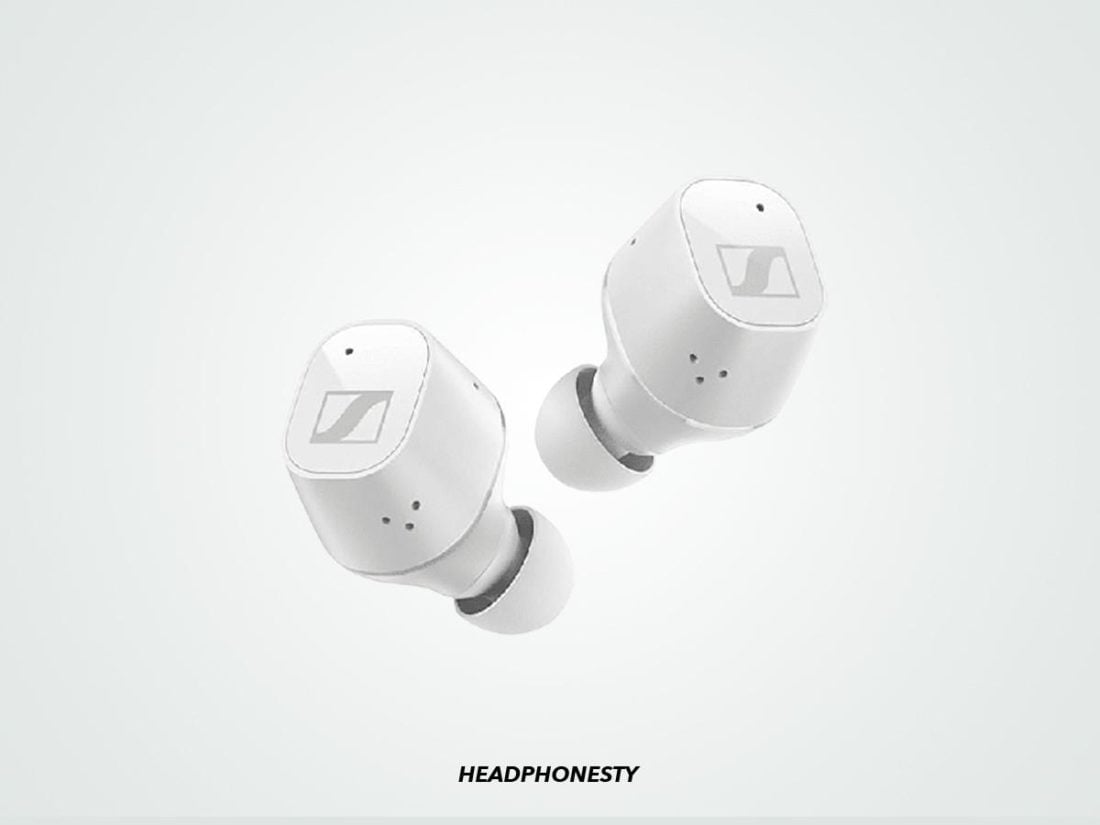
Key features
- Type: True Wireless
- Connectivity: Wireless
- Bluetooth audio codecs: SBC, AAC, aptX™, aptX Adaptive
- Battery Life: 8 hours
- Frequency Range: 5 – 21kHz
- Sensitivity: 114 dB
- Impedance: N/A
- Mic: Yes
- ANC: Yes
- App Support: Sennheiser Smart Control
Often compared to the MOMENTUM True Wireless 2 are the Sennheiser CX Plus. Although these two earbuds have identical features, some key differences make the CX Plus the better choice for sports.
For starters, the CX Plus feature 7mm TrueResponse transducers for clearer sounds. Paired with the Bass Boost feature, these earbuds will give you punchier bass and energetic highs. These earbuds also have a sensitivity of 114 dB so they’re quite loud. If you’re looking for that additional pump during your workouts, these features could help you.
Both the MOMENTUM True Wireless 2 and the CX Plus have an IPX4 rating so they are resistant to sweat damage. But, the CX Plus has an 8-hour battery life which is an hour more than the TW2. The CX Plus charging case, though, has 4 hours less (24 hours) than the TW2. Nonetheless, both these headphones have great numbers for their battery and would easily last through multiple workouts.
As with the MOMENTUM Wireless 2, the CX Plus also feature ANC if you need that extra focus during your activities. Should you need to hear your surroundings, you can also turn on Transparent Hearing. You can customize the touch controls of the CX Plus through the Smart Control App as well. This gives you the freedom to set commands that will let you control the functions of the earbuds more comfortably.
However, the ANC on the CX Plus needs to be developed further because it’s not powerful enough to truly cancel out most noise.
